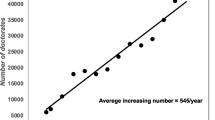Abstract
The influence of various factors upon the shape of Bradford's bibliograph was assessed through an examination of 16 bibliographies, of which ten were comprehensive. We obtained a curvature score for each bibliograph plotted in a standard landscape format so as to permit comparison; we found that the amount of concave up curvature (“convexity”): (a) is negatively correlated with a bibliography's overall publication density; (b) depends on the status (“technical” vs. “nontechnical”) of the disciplinary source of a bibliography, with technical disciplines showing less convexity; and (c) is complexly affected by the historical changes in the discipline. Findings are discussed in the context of questions about the graphical formulation of Bradford's Law.
Similar content being viewed by others
References and notes
S. C. Bradford, Sources of information on specific subjects,Engineering, 137 (1934) 85–86. Reprinted in:Collection Management, 1 (1976–1977) 95–103 and in:Journal of Information Science, 10 (1985) 148, 176–180. Following standard scholarly practices, page references to Bradford's paper are to the original publication.
Other writers have assumed that Bradford's verbal law was the first. See p. 125 ofE. A. Wilkinson, The ambiguity of Bradford's law,Journal of Documentation, 28 (1972) 122–130.
For example,Wilkinson, Ambiguity, pp. 123–124.
B. C. Vickery, Bradford's law of scattering,Journal of Documentation, 4 (1948) 198–203.
M. G. Kendall, The bibliography of operational research,Operational Research Quarterly, 11 (1960) 31–36.
H. A. Simon, On a class of skew distribution functions,Biometrika, 42 (1955) 425–440.
For example,F. F. Leimkuhler, The Bradford distribution,Journal of Documentation, 23 (1967) 197–207;L. Egghe, Consequences of Lotka's law for the law of Bradford,Journal of Documentation, 41 (1985) 173–189.
L. Egghe, Application of the theory of Bradford's law to the calculation of Leimkuhler's law and to the completion of bibliographies,Journal of the American Society for Information Science, 41 (1990) 469–492.
B. C. Brookes, Bradford's law and the bibliography of science,Nature, 224 (1969) 953–956.
E. g.,Brookes, Bibliography of science.
E. g.,Brookes, Bibliography of science;M. C. Drott, B. C. Griffith, An empirical examination of Bradford's law and the scattering of scientific literature,Journal of the American Society for Information Science, 29 (1978) 238–246;T. A. Brooks, Clustering in comprehensive bibliographies and related literatures,Journal of the American Society for Information Science, 41 (1990) 183–192.
S. R. Coleman, Bradford distributions of social-science bibliographies varying in definitional homogeneity,Scientometrics, 27 (1993) 77–93.
H. Selye,The Mast Cells, Washington; Butterworths, 1965. The quotes are taken from xii and p. 6. The mast-cell bibliograph and the bibliograph for schistosomiasis are presented in:W. Goffman, K. S. Warren, Dispersion of papers among journals based on a mathematical analysis of two diverse medical literatures,Nature, 221 (1969) 1205–1207.
J. Klein, XY. COM, ver 1.2 [User-supported, shareware computer-graphic software]. Raleigh, NC: National Collegiate Software Clearinghouse, 1985. The program autoscaled all bibliographs to the same, 3∶4 format, regardless of the differences in size of the bibliographs; the uniform format permitted comparison of the curvature scores.
The procedure does not constitute an assertion that the observed data-set is best described as convex (or concave), for the apparent form may clearly be S-shaped. The procedure only asumes that the display includes a quadratic “trend” whose direction and magnitude can be indexed by the curvature score: SeeD. A. Grant, Analysis of variance tests in the analysis and comparison of curves,Psychological Bulletin, 53 (1956) 141–154. Other measures of curvature are possible, and a calculus-based measure was suggested by a reviewer of an earlier version of this paper: see pp. 486–492 ofC. H. Edwards, Jr., D. E. Penney,Calculus and Analytic Geometry, Englewood Cliffs, NJ, Prentice-Hall, 1982. We examined alternative measures of curvature, scrutinizing their distributional properties and correlation with one another and with some of the bibliographic features we examine in this article.Appendix 2 presents results from our examination, results that warrant our use of the measure of curvature that we describe in the current article.
See pp. 39–50 ofJ. F. Hair, R. E. Anderson, R. L. Tatham,Multivariate Data Analysis with Readings, 2nd. ed., New York, Macmillan, 1987.
D. de S. Price, ups and downs in the pulse of science and technology. In:J. Gaston (ed.),The Sociology of Science, San Francisco, 1978, Jossey-Bass, pp. 162–171.
Cited in:Egghe, Application of the theory, pp. 486–487.
B. C. Peritz, A Bradford distribution for bibliometrics,Scientometrics, 18 (1990) 323–329.
Cf. the proposal that fast growth has the immediate effect of spreading articles over many journals that will publish only one or two articles on the topic, thus producing convexity:H. Eto, Rising tail in the Bradford distribution: Its interpretation and application,Scientometrics, 13 (1988) 271–287.
S. R. Coleman, S. Webster, The decline of a research specialty: Human eyelid conditioning in the late 1960s,Behavior and Philosophy, 18 (1990) 19–42.
SeeEto, Rising tail.
Author information
Authors and Affiliations
Rights and permissions
About this article
Cite this article
Coleman, S.R. Disciplinary variables that affect the shape of Bradford's bibliograph. Scientometrics 29, 59–81 (1994). https://doi.org/10.1007/BF02018384
Received:
Issue Date:
DOI: https://doi.org/10.1007/BF02018384




